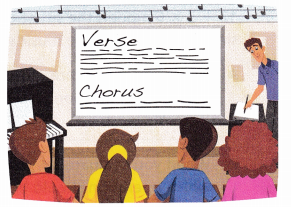We included HMH Into Math Grade 5 Answer Key PDF Module 4 Lesson 3 Evaluate Numerical Expressions to make students experts in learning maths.
HMH Into Math Grade 5 Module 4 Lesson 3 Answer Key Evaluate Numerical Expressions
I Can evaluate a numerical expression using the order of operations.
Spark Your Learning
Mr. North’s music club writes a song together. Each verse of the song has 6 lines, and each chorus has 2 lines. If the song has 4 verses and choruses, how many lines does the song have in all?

Draw a visual model to show the problem. Explain your reasoning.

Answer:

26 lines,
Explanation:
Given Mr. North’s music club writes a song together.
Each verse of the song has 6 lines, and each chorus has 2 lines. If the song has 4 verses and choruses,
So the number of lines does the song have in all are
4 X 6 + 2 = 26 lines.
Turn and Talk Think about a numerical expression that models the number of lines in the song. If the song is shortened from 4 verses and choruses to 3, how does the numerical expression and its value change?
Answer:
4 X 6 + 2 X 3,
Value increases by 4 more lines,
Explanation:
Now a numerical expression that models the number of lines in the song. If the song is shortened from 4 verses and choruses to 3 is 4 X 6 + 2 X 3 = 24 + 6 = 30 lines, the value changes from 26 lines to 30 lines increases by 30 – 26 = 4 more lines.
Build Understanding
1. A club is making a music video. A group of 12 singers perform the first verse. Three different groups of 6 singers perform the other 3 verses. The numerical expression 12 + 3 × 6 models the situation. How many singers are making the music video?
A. Which operations are modeled in the numerical expression?

B. When you evaluate the numerical expression, which operation should be done first? How do you know?
C. Describe how to evaluate 12 + 3 × 6.
D. Evaluate the numerical expression, then explain what your answer means in this situation.
E. How many singers are making the music video?
Answer:
30 singers,
A. addition + and multiplication X,
B. Multiplication,
C. first 3 X 6 then add 12,
D. 12 + 18,
E. 30 singers are making the music video,
Explanation:
Given a club is making a music video.
A group of 12 singers performs the first verse. Three different groups of 6 singers perform the other 3 verses. The numerical expression
12 + 3 × 6 models the situation.
The number of singers are making the music video are 12 + 3 X 6 = 12 + 18 = 30 singers,
A. Operation + addition and multiplication X is modeled in the numerical expression,
B. First multiplication operation should be done as 1 group is already there and other groups should be known then we can solve,
C. To evaluate 12 + 3 × 6 we calculate first by multiplying 3 X 6,
D. 12 + 18 by adding 18 to 12, we get number of singers,
E. 12 + 18 = 30 singers are making the music video.
Connect to Vocabulary
To evaluate a numerical expression, find its value by carrying out all of its operations in the correct order. The order of operations is a set of rules for evaluating a numerical expression.
The order of operations is:
- Perform operations in parentheses.
- Multiply and divide from left to right.
- Add and subtract from left to right.
Turn and Talk Why do the two expressions (12 + 3) × 6 and 12 + 3 × 6 have different values?
Answer:
Due to order of operations,
Explanation:
Given two expressions (12 + 3) X 6 and
12 + 3 X 6 have different values because in (12 + 3) X 6 first we calculate values in parentheses as 15 X 6 = 90, in second
expression 12 + 3 X 6 we first do multiplication 12 + 18 = 30 so we get different values.
Step It Out
2. The club members spend 4 hours rehearsing and 2 hours filming a music video for 3 Saturdays. The numerical expression (4 + 2) × 3 can be used to model the situation.

A. Rewrite (4 + 2) × 3 using repeated addition, then evaluate.
B. Rewrite (4 + 2) × 3 using the Distributive Property, then evaluate.
C. Use the order of operations to evaluate (4 + 2) × 3. How many hours do the club members spend making the video?
Answer:
A. (4 + 2) + (4 + 2) + (4 + 2),
B. (4 X 3) + ( 2 X 3) = 12 + 6 = 18,
C. parentheses then multiplication, 6 X 3 = 18, 18 hours to make the video,
Explanation:
Given the club members spend 4 hours rehearsing and 2 hours filming a music video for 3 Saturdays.
The numerical expression is (4 + 2) × 3,
A. Rewriting (4 + 2) × 3 using repeated addition is
(4 + 2) + (4 + 2) + (4 + 2),
B. Rewriting (4 + 2) × 3 using the Distributive Property is
(4 X 3) + + ( 2 X 3) = 12 + 6 = 18,
C. Using order of operations for (4 + 2) X 3 first we use parentheses and then multiplication as
(6) X 3 = 18, therefore number of hours do the club members spend in making the video is 18 hours.
Turn and Talk How do the methods you used to evaluate the numerical expression compare?
Answer:
Compared by order of operations used and by >,< or =,
Explanation:
The methods I used to evaluate the numerical expression are compared by the order of operations I used and by greater or less than or equal to.
Check Understanding Math Board
Question 1.
Ervin evaluates 12 ÷ (2 + 4) + 6 × 3 by first dividing 12 ÷ 2 and then multiplying 6 × 3. Then, he adds from left to right. Explain his errors.
Answer:
First is not dividing 12 ÷ 2,
Its addition in parentheses (2 + 4),
Explanation:
Given Ervin evaluates 12 ÷ (2 + 4) + 6 × 3 by first dividing 12 ÷ 2 and then multiplying 6 × 3. Then, he adds from left to right.
The error in Ervin evaluation is first he should follow
order of operation as perform operations in parentheses.
Addition (2 + 4) not 12 ÷ 2,
Evaluate the numerical expression.
Question 2.
4 × (15 – 7) + 8
Answer:
40,
Explanation:
Given the numerical expression
4 X (15-7) + 8 to evaluate so
4 X 8 + 8,
32 + 8 = 40.
Question 3.
12 × 12 + 7 × 8 + 5
Answer:
205,
Explanation:
Given the numerical expression
12 × 12 + 7 × 8 + 5 to evaluate so multiply and add from left to right
144 + 56 + 5 = 205.
On Your Own
Question 4.
Model with Mathematics Ms. Garcia has 120 comic books. She gives 15 to each of her three nephews, then buys 4 more. Write and evaluate a numerical expression that describes the number of comic books she has now.
Answer:
79 number of comic books she has now,
Explanation:
Given Ms. Garcia has 120 comic books.
She gives 15 to each of her three nephews, then buys 4 more.
Numerical expression that describes the number of comic books she has now are
120 – (15 X 3) + 4,
120 – 45 + 4,
79, therefore 79 number of comic books she has now.
Evaluate the numerical expression.
Question 5.
35 – 5 × (12 – 7)
Answer:
10,
Explanation:
Given to evaluate the numerical expression
35 – 5 × (12 – 7), first we evaluate parentheses,
35 – 5 X (5),
35 – 25 = 10.
Question 6.
12 + 6 ÷ 3 + 3
Answer:
17,
Explanation:
Given to evaluate the numerical expression
12 + 6 ÷ 3 + 3 first we divide,
12 + (6 ÷ 3) + 3,
12 + 2 + 3,
17.
Question 7.
18 ÷ 6 + 12 – 1
Answer:
14,
Explanation:
Given to evaluate the numerical expression
18 ÷ 6 + 12 – 1 first we evaluate division,
3 + 12 – 1,
15 – 1 = 14.
Question 8.
3 + 9 × 8 – 4
Answer:
71,
Explanation:
Given to evaluate the numerical expression
3 + 9 X 8 – 4 first we evaluate multiplication
3 + 72 – 4,
75 – 4 = 71.
Question 9.
Consider the expression (4 × 3 – 1) × 5. For a numerical expression with multiple operations in the same set of parentheses, in which order should you perform the operations? Evaluate this expression.
Answer:
55,
Explanation:
Considering the expression (4 × 3 – 1) × 5
first in order to perform operations for multiple operations in the same set of parentheses, we perform values of parentheses as (4 x 3 – 1) = 12 – 1 then we subtract and multiply 11 X 5 = 55.
I’m in a Learning Mindset!
What is different about trying to evaluate a numerical expression with a partner than trying to solve it on my own? Which do I prefer?
Answer:
own,
Explanation:
I prefer own to evaluate a numerical expression than with a partner because I can use order of operations correctly.